LP9: Pinoy-Style Chicken Liver Steak
Awful offal, I assume, includes heart, liver, lungs, animal’s entrails, plus tails, feet, and heads. This practice or custom of preparing offal dishes may (or may not) be a reflection of a culture’s economy and resourcefulness.
When we were young, Dad maintained a poultry farm in our backyard and distributed dressed chickens to wholesalers and neighbors. So just imagine offal overload. Our meals were full of chicken parts – not only the prime and choice parts. Think of adobong paa ng manok, chicharong isaw ng manok, chicharong balat at taba ng manok, dinuguan using chicken blood. (Chicken feet cooked in vinegar, salt, garlic, pepper and soy sauce, chicken chitlin/skin/fat cracklings, chicken blood stew.) The best would be adobong atay at balunbalunan – the most widely eaten lamang loob. A lot of people say that in chicken nothing is wasted. But of course, not everybody likes what it offers. I for one wouldn’t dare touch a chicken head. I’ve tried it and I don’t wanna ever look back though I would lovingly go to the nearest dim sum restaurant for chicken feet.
So it was like our meals were full of chicken feet than we ever wanted – adobong manok with adidas (dish cooked in vinegar, salt, garlic, pepper and soy sauce), tinolang manok with adidas (ginger stew), fried whole chicken complete with adidas. You name it we had it that for years I couldn’t bring myself to eat chicken until I was about 16. The chicken feet? Till the time I discovered dim sum in my early 20s.
I’m not one of those who stay away from offal dishes though I seldom cook such as I tend to be the only one who enjoys ‘em. Lasang Pinoy 9, hosted by Cia over at Pabulum, is all about lamang loob or innards and again I was tempted to buy the intimidating chitlins (check out my adobong isaw for LP6) but decided to cook the less controversial chicken liver instead. Chicken liver steak – mala bistek. (Read: Too busy with work I have no time to go to a decent supermarket to buy ingredients.)
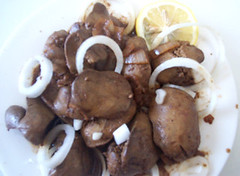 Bistek is a Filipino-style beef steak typically made with strips of sirloin beef cooked in soy sauce, calamansi juice and onion rings. Sometimes we substitute beef with pork while using liver makes a good appetizer. Here’s how I did mine as I remember it the way my sister cooked it the last time she visited me here in Beijing.
Bistek is a Filipino-style beef steak typically made with strips of sirloin beef cooked in soy sauce, calamansi juice and onion rings. Sometimes we substitute beef with pork while using liver makes a good appetizer. Here’s how I did mine as I remember it the way my sister cooked it the last time she visited me here in Beijing.

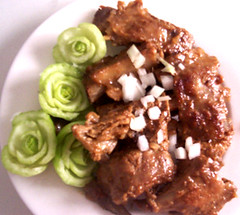 I’ve been experimenting with Chinese cooking wine lately since I found a bottle in a supermarket a month ago. So far it’s a hit! This was lunch last Easter Sunday. Those green roses are actually the bottom part of pechay where the stalks meet. We didn’t eat ‘em. They just look pretty next to the spareribs.
I’ve been experimenting with Chinese cooking wine lately since I found a bottle in a supermarket a month ago. So far it’s a hit! This was lunch last Easter Sunday. Those green roses are actually the bottom part of pechay where the stalks meet. We didn’t eat ‘em. They just look pretty next to the spareribs.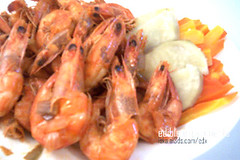 Happy Easter! So busy with giving a fresh new look to our HS class website (using
Happy Easter! So busy with giving a fresh new look to our HS class website (using 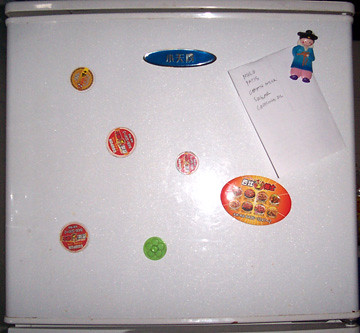






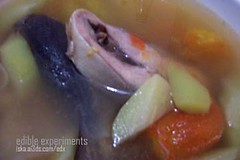 I still have few pictures of my mom’s cooking taken during my last vacation that I want to share. Here is one of her many variations of sinigang (sour broth). Sinigang maybe cooked with fish, meat (maybe lean meat, fatty or bony parts) or shellfish. Vegetables vary depending on availability and, of course, preference. The most common souring agents are fresh sampalok (tamarind), bayabas (guava), kamias (bilimbi) or simply a pouch of sinigang mix available at the store nearest you.
I still have few pictures of my mom’s cooking taken during my last vacation that I want to share. Here is one of her many variations of sinigang (sour broth). Sinigang maybe cooked with fish, meat (maybe lean meat, fatty or bony parts) or shellfish. Vegetables vary depending on availability and, of course, preference. The most common souring agents are fresh sampalok (tamarind), bayabas (guava), kamias (bilimbi) or simply a pouch of sinigang mix available at the store nearest you.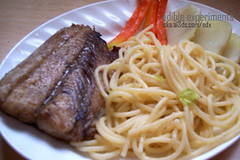 The staple of the Filipino food is rice but for the sake of variety I sometimes prepare bread or noodle or corn for the much needed daily carbohydrate intake. Here, I pan-fried few processed fish fillets and served them with pasta tossed in olive oil, parsley, Italian herbs and parmesan cheese – another easy to prepare dish as well as a truly mouth-watering meal!
The staple of the Filipino food is rice but for the sake of variety I sometimes prepare bread or noodle or corn for the much needed daily carbohydrate intake. Here, I pan-fried few processed fish fillets and served them with pasta tossed in olive oil, parsley, Italian herbs and parmesan cheese – another easy to prepare dish as well as a truly mouth-watering meal!
 Now that it’s going to be my turn to host
Now that it’s going to be my turn to host 
